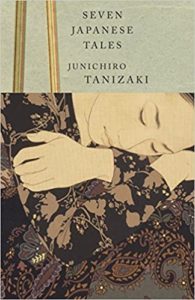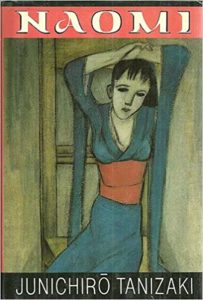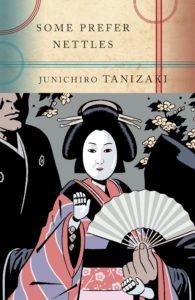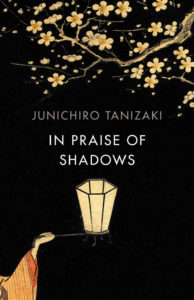
A Mind-Changing Interpretation of Japanese Aesthetics
In Praise of Shadows, by Junichirō Tanizaki (translated by T. J. Harper & E. Seidensticker) Vintage Classics, Nov. 2019.
Reviewed by Renae Lucas-Hall
A new fully-illustrated release of In Praise of Shadows by Junichirō Tanizaki, translated by Thomas J. Harper and Edward G. Seidensticker, has just been published by Vintage Classics. It comes with stunning images chosen by the iconic book cover designer Suzanne Dean. This short but detailed essay on Japanese aesthetics provides deep insight into a culture with more layers than a senshyu onion.
Tanizaki was born in 1886 and died in 1965. He’s one of Japan’s most acclaimed writers, well-known for his intricate understanding of Japanese society. He’s favoured for his attention to detail and the magic he evokes but this fascinating essay in addition to being an inspiring work of non-fiction, is complemented by stunning calligraphy, ukiyo-e woodblock prints and delicate washi paper patterns.
“My concept for the redesign included the fold–out cover and full colour text design. I wanted the fold-out cover to feel architectural. The idea of the pages getting darker through the book came to me as I read the text. Shadow and tone felt so important.”
The cover features part of the illustration Woman Admiring Plum Blossoms at Night by the woodblock print artist Suzuki Harunobu. “I loved the way the woman is holding up the lantern. I cropped the picture to keep the design simple and clean,” said Dean in an email interview.
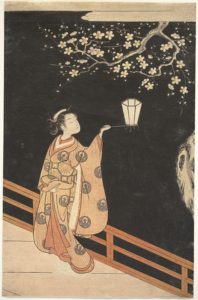
The emphasis on plum blossoms for the cover ties in perfectly with the contents. The author’s ephemeral thoughts are expressed in a haphazard manner as he jumps from one subject to the next. Plum and cherry blossoms express beauty that is fleeting and therefore precious.
Japan has long been considered a land of mystery, difficult for Westerners to understand. Tanizaki breaks down these illusions by proving darkness can be more conducive to relaxation and meditation.
Throughout this discourse, the author reveals his preference for low lights over bright electric illumination. Westerners may be more inclined to drench their homes in sunlight and flick on an electric switch but this writer is partial to shadows filtering through shoji paper screens that cast striking silhouettes onto tatami mats woven with natural straw.
Readers might assume this wordsmith, a purist and lover of Japanese traditions, is a fan of both Kabuki and Nō theatre, the latter being the oldest surviving form of theatre in the world. But Tanizaki dislikes the way the Kabuki actors’ faces, covered in heavy makeup, look so harsh under modern floodlights. He’d rather watch the participants in the more subdued Nō theatre. For him, nothing is more beautiful nor convincing.
Tanizaki finds the modern use of ceramics detestable and instead prefers the splendour of lacquerware. When he eats in a traditional Japanese restaurant, he likes to sit at a table illuminated by candlelight. For him, this is the best way to admire the beauty of a lacquer miso soup bowl. Looking into the multi-layered richness of up to 30 layers of lacquer, reminds him of a deep pond.
A subject one would likely never expect the author to dwell upon so passionately is the type of toilet one finds at a temple in Kyoto or Nara. Yet he is persuasive in his description of this convenience in a traditional setting. When he mentions the scent from the moss on stepping stones, the sound of insects or falling rain, one begins to understand. Add to that a view of the moon and lavatory walls with a grained wood effect, one feels like a trip to the loo can be an occasion to cherish! Rather than stark white tiles and shiny metal taps in Western bathrooms he opts for designs that allow for contemplation and spiritual repose.
This book was first published in the 1930’s but Japan has radically evolved and modernized in ways the Japanese of the early Shōwa period would never have imagined. Is Tanizaki’s appreciation of shadows outdated? Maybe a little, but a more fulfilling understanding of Japanese aesthetics wouldn’t be possible without the master’s postulations in this remarkable book.
About the Reviewer
Renae Lucas-Hall is an Australian-born British novelist and writer at Cherry Blossom Stories. She completed a B.A. in Japanese language and culture at Monash University and an Advanced Diploma in Business Marketing at RMIT University. She is the author of Tokyo Hearts: A Japanese Love Story (2012, ranked number one in Coming of Age books on Amazon Japan) and Tokyo Tales: A Collection of Japanese Short Stories (2014). Connect with Renae on Twitter, Instagram and Facebook. Visit her website cherryblossomstories.com.
About the Author
Jun’ichirō Tanizaki (1886–1965) is one of Japan’s most famous authors. His other books include:
Some Prefer Nettles (or Kindle Japan 500 yen)
The Key and Diary of a Mad Old Man
A Cat, a Man and Two Women (Kindle JP here)
Quicksand (Kindle JP 550 yen here)


